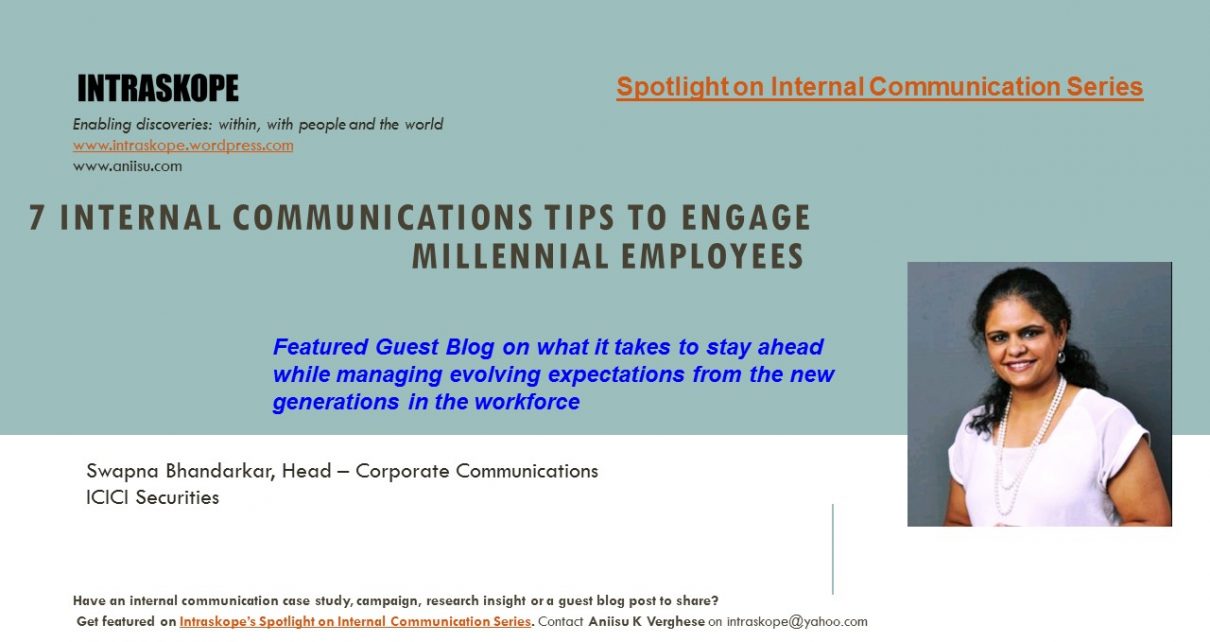In the third edition of Intraskope’s Spotlight on Internal Communication Series, Swapna Bhandarkar – Head Corporate Communications at ICICI Securities shares a guest blog.
Views expressed by Swapna are personal and do not reflect the views of the organization she works for.
A recent study by Deloitte indicates an evolution in the attitudes of millennials due to the geo-political scenarios globally – with most feeling pessimistic about their future. They prefer leaders who are inclusive and are direct in their communication while wanting to contribute to employers who add value to the communities around them. Millennials also prefer personalization and flexible working, according to the Microsoft Asia Workplace 2020. In this guest blog post, Swapna addresses challenges that internal communicators can face and offers tips to engage millennials.
Multi-generational phenomenon
Most organizations are experiencing a unique phenomenon – of multi-generational workforces – from the ‘close to retirement’ baby boomers group to the Generation Z who are beginning to join the workforce and Millennials who comprise the biggest segment among them all.
While communicators viewed internal communication as a simplistic tool to engage and communicate corporate milestones with baby boomers and Generation X, the millennials expect two-way communication and better quality of conversations with their leaders. And globally, corporations are listening to this need for effective and efficient internal messaging for this set of employees.
Facebook Emojis, Twitter, and Instagram forwards only indicate that Millennials love feedbacks. This year in July we witnessed Sarahah, a free social media app that lets you receive comments from friends and strangers anonymously and is outpacing mainstays like Snapchat and Facebook on the Apple App Store. The app has more than 62 million users across the globe anonymously sharing their feedback with strangers. While we may debate the efficacy of this app, the fact remains that millennials, who are the primary users of this app, are keen to hear if from their network.
Digital comes of age
Hence an organizational communication that doesn’t address their questions or takes into account their opinions will fail to engage and may suffer from a dissatisfied workforce that does not believe the company is new-age and innovative.
Two decades ago, when I began my journey as a communication specialist, many organizations used to spend time and money on employee newsletters. We produced a 5-10 page magazine with photos and messages from various business heads. The magazine copies placed on employees’ desks barely caught attention.
Today, in a digitally connected world organizations that have embraced online communications through interactive intranet platforms like Yammer or Facebook for office have benefitted by engaging employees real-time. Such platforms give employees a conducive environment to discuss their concerns, seek solutions and learn from others. It also fosters innovation. However, the biggest advantage is that when firms provide a platform to employees to freely speak their mind, it reinforces employees’ trust in the organization.
Building employee advocates
Great brands are built from the inside-out. An engaged employee who believes and trusts its firm will be the biggest brand advocate who delivers the promise and greatly improves customer satisfaction. While going digital is a powerful approach to build employee trust and satisfaction, like my favorite superhero says, ‘with great power comes great responsibility’, it also puts the onus on communicators to help Millennials succeed in the workplace by investing in two way, interactive and transparent communication.
Here are 7 tips that can help communicators tap the power of digital while engaging millennials –
- Accessibility everywhere– Use your internal communication budgets wisely to invest in a robust digital platform that considers the aspirations of millennials. Going mobile with internal apps is a good way to engage this group of employees.
- Visual communication and collaboration – Create and provide opportunities for millennials to express themselves through creative forms of communication. Transform your standard newsletter topics such as ‘message from the CEO’s desk’ or ‘coffee with business heads’ into snappy videos shot on a phone camera. Involve and invite your employees to shoot these videos. It will create excitement and communication to look forward to.
- Storytelling platform – encourage performers to tell their stories through blogs or photographs. Create a feedback mechanism that will encourage them to share more content.
- Short and succinct – employees prefer to absorb information in bite-sized chunks. Concise updates with further information available via hyperlink suit this generation well.
- Hone talent – Encourage employees to showcase their talent – be it in singing, art among others. By helping them find meaning at work and beyond can help them stay more committed to the employer.
- Bring recognition to the fore– Recognize and reward regular contributors on the platform. Present them with badges or vouchers based on their contribution to knowledge sharing and practices.
- Refresh messages often– By far, the most important insight is to keep the platform updated and relevant. Even if there is a crisis, ensure that the messages are timely and inclusive.
With organizations getting flatter, engaging employees, especially millennials will need effective internal communication.
Are you an internal communication practitioner working in a firm or a not-for-profit? Have an internal communication case study, campaign, research insight or a guest blog post to share? Get featured on Intraskope’s Spotlight on Internal Communication Series. Contact me on [email protected]

